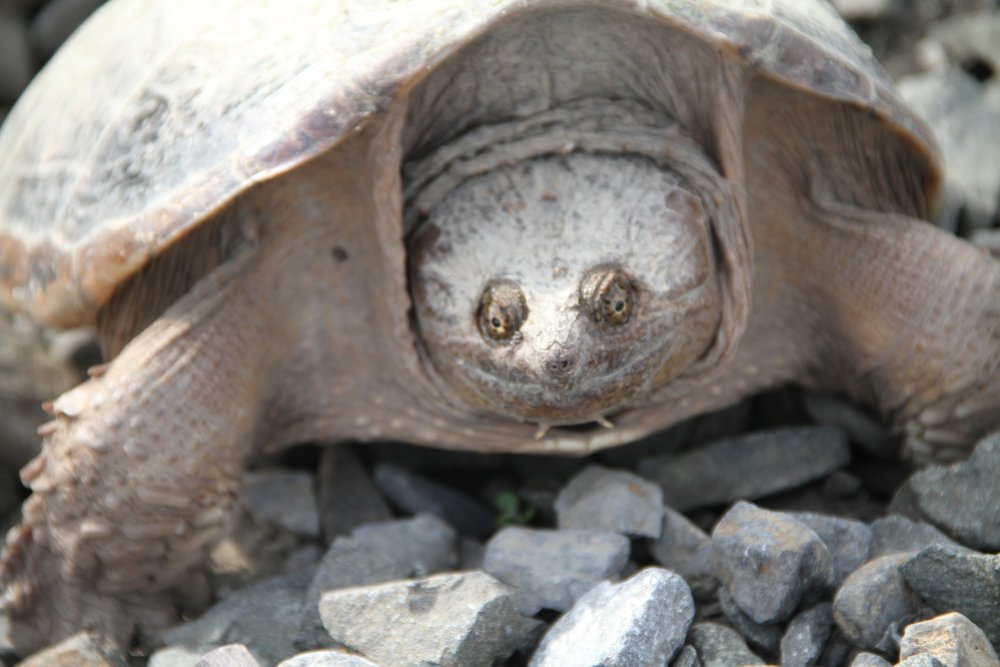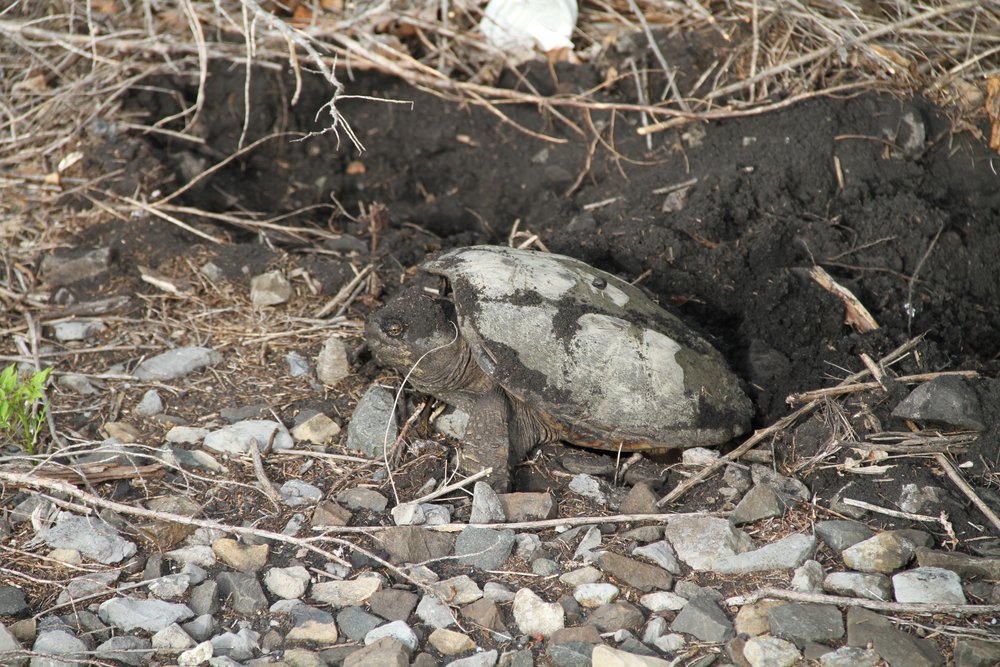 The snapping turtle rested between the rails of the north bound Amtrak line that rims the Hudson River. If she stayed there, she would be fine, that is, a train would simply sail over her. It must have taken some determination for her to get over the railing—that is the biological willpower of a snapper who wants to lay eggs. But she now looked weary, as if she might not have the resources to get back out. If she loitered on the rails—she’d end up squashed. Another turtle just twenty feet away, lay with its shell caved in, head severed.
The snapping turtle rested between the rails of the north bound Amtrak line that rims the Hudson River. If she stayed there, she would be fine, that is, a train would simply sail over her. It must have taken some determination for her to get over the railing—that is the biological willpower of a snapper who wants to lay eggs. But she now looked weary, as if she might not have the resources to get back out. If she loitered on the rails—she’d end up squashed. Another turtle just twenty feet away, lay with its shell caved in, head severed.
 Picking up snapping turtles has never been my specialty. I’ve saved many wandering across the road, and though I’ve prodded and coaxed with ranging success, I’ve never perfected my snapping turtle rescue technique. A few weeks ago an enormous turtle lumbered her way up a back country road. Another car had already stopped. I joined the two women as we debated best methods. Two men joined us and they searched their car for a bucket while their dog peered out of the window. Soon a mother and her son appeared from down the hill with a net. “We have them all the time in our yard,” she said. “They fall in our pool.” The net was a great tool—with a simple scoop, the turtle was up and deposited over the guardrail.
Picking up snapping turtles has never been my specialty. I’ve saved many wandering across the road, and though I’ve prodded and coaxed with ranging success, I’ve never perfected my snapping turtle rescue technique. A few weeks ago an enormous turtle lumbered her way up a back country road. Another car had already stopped. I joined the two women as we debated best methods. Two men joined us and they searched their car for a bucket while their dog peered out of the window. Soon a mother and her son appeared from down the hill with a net. “We have them all the time in our yard,” she said. “They fall in our pool.” The net was a great tool—with a simple scoop, the turtle was up and deposited over the guardrail.
But Christina and I—searching for early morning birds—had no net with us there by the train tracks.
Christina suggested picking it up by its tail. That is the most frequent method of snapper removal, “but hold it away from your legs,” one friend warned.
“I’ve heard that isn’t good for the turtle,” I offered, while also worrying that the long neck of the turtle would swing around and snap her.
“Getting killed isn’t much better,” she pointed out, too wise for a 21-year-old.
“I’ve heard you can get them to latch onto a stick and move them that way.” We offered a stick to the turtle who seemed dumbstruck with our idea. She didn’t snap.
We then did what all turtle rescuers do: we stared at the turtle. We took photographs.
“Isn’t it great to photograph something that isn’t moving?” Christina joked. We spend a lot of time together trying to find birds, then snap fleeting photos. This was a treat. We were able to analyze the turtle’s steady yellow eyes that held a bit of contempt for the world and for us in particular. There were little barbells on her chin, like fangs, and all of her skin was droopy. The claws on the front feet impressed me. Unlike other turtles that shrink into their shells when frightened, the snapper can’t retract its enormous head and legs. It remains vulnerable to the world. Or, thought of another way, ready to attack the world.
 While we loitered there, I hoped a train would not come swooshing by. I don’t like walking the tracks (and, it’s not legal), but sometimes I do to get to those special spots on the edge of the North or South Tivoli Bay. The tracks have severed both of these bays from the main body of the Hudson River, and they exist as their own special places. The gravel that covers dark soil bordering the rails is a favorite for nesting snapping turtles. On this morning walk, we stumbled upon twelve turtles, all dinner-plate sized digging in the soil or enroute to do so. We also saw dozens of nests, dug up, the eggs shredded and curling white against black soil. Near them we could see the soft, small prints of raccoons. It’s a rough life for a turtle. If you add Amtrak to the expected predators—that seemed too much. We had to save this turtle.
While we loitered there, I hoped a train would not come swooshing by. I don’t like walking the tracks (and, it’s not legal), but sometimes I do to get to those special spots on the edge of the North or South Tivoli Bay. The tracks have severed both of these bays from the main body of the Hudson River, and they exist as their own special places. The gravel that covers dark soil bordering the rails is a favorite for nesting snapping turtles. On this morning walk, we stumbled upon twelve turtles, all dinner-plate sized digging in the soil or enroute to do so. We also saw dozens of nests, dug up, the eggs shredded and curling white against black soil. Near them we could see the soft, small prints of raccoons. It’s a rough life for a turtle. If you add Amtrak to the expected predators—that seemed too much. We had to save this turtle.
We both found flat boards. From one side, Christina pried under the turtle and I did the same on the other side. Balancing, we lifted in unison while the turtle let off a musky pee. We stepped the turtle down the gravel embankment and into the shrubs lining the North Tivoli Bay. For the moment, the turtle was safe.


